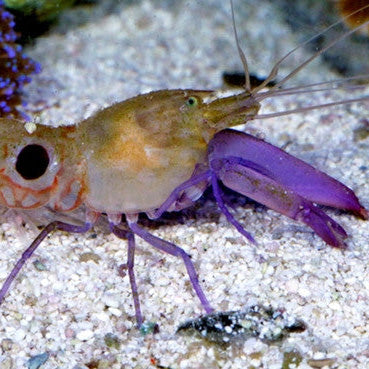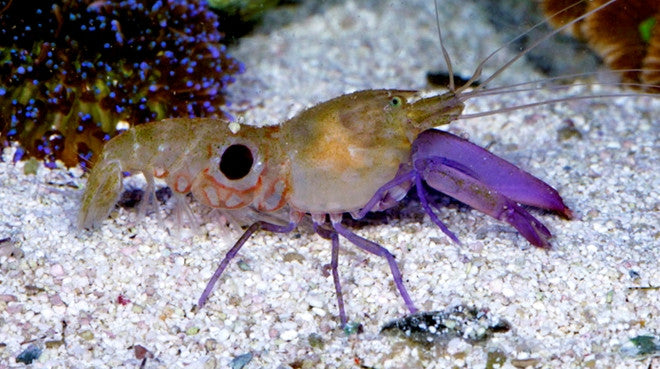Everyday low prices. Free Shipping Over $249. Or $29.99 Flat Rate Over $100
Bullseye Pistol Shrimp
$ 59.99
Please select all options.
How to Care for Bullseye Pistol Shrimp
written by Dave Burr
The Bullseye Pistol Shrimp has a specialized claw that creates a loud clicking noise when it is open or closed. You can hear this noise from outside the aquarium if you listen closely. The Bullseye Pistol Shrimp uses this claw to ward off predators and knock over potential prey. It will scavenge the aquarium eating bits of algae and scraps of meaty food. Unlike most other Pistol Shrimp the Bullseye Pistol Shrimp does not create a symbiotic relationship with gobies. It prefers to live by itself.
Predators: Triggers, larger Hawkfish, Groupers, Lionfish, and large predatory Wrasses may eat Bullseye Pistol Shrimp. They are best kept with reef safe fish.
Feeding: Offer the Bullseye Pistol Shrimp small pieces of meaty foods.
Growth: Maintaining proper pH, Ca, Alk, & Mg levels is important for shrimp. Providing additions of iodine will help the shrimp to molt and grow.
Acclimation: Take the time to do a drip acclimation with any shrimp as they do not tolerate rapid changes in water chemistry very well.
Care Level: EasyReef Compatible: Yes
Diet: Omnivore
Range: Indo-Pacific
Family: Alpheidae
Water Conditions: 75-80° F; sg 1.024-1.026 (1.025 is ideal); pH 8.1-8.4 Ca 420-440 ppm, Alk 8-9.5 dKH, Mg 1260-1350, Nitrates <10ppm, Phosphates < .10ppm
Water Chemistry: It is important that proper calcium (420-440 ppm), alkalinity (8-9.5 dkh - run it 7-8 if you are carbon dosing) , and magnesium levels (1260-1350 ppm) are maintained. Raising magnesium levels gradually up to 1400-1600 ppm can help to combat algae outbreaks, just keep CA and Alk in line as you raise the Mg. Nitrates should be below 10 ppm and phosphates should be below .10 ppm. We recommend doing a water change when Nitrate levels rise to 10 ppm. It is important to replace your phosphate media when phosphates rise to .10 ppm. Media Reactors make the most efficient use of your phosphate media by fluidizing it.
Dosing: Vivid Aquariums uses and recommends dosing pumps to automate the dosing of additives and keep your levels more constant. A dosing pump can alleviate the chore of manually dosing your aquarium with Ca, Alk, & Mg 2,3, or 4 times per week and will benefit your aquarium by keeping your levels constant through frequent small additions of Ca, Alk, & Mg. Our tanks all progressed when we switched from 3 manual dosings per week to 70 automatic dosings per week and we got a lot more work done.
Category: 50-75, alpheus-soror, easy, omnivore, Shrimp, symbiotic-relationships
Type: Shrimp



